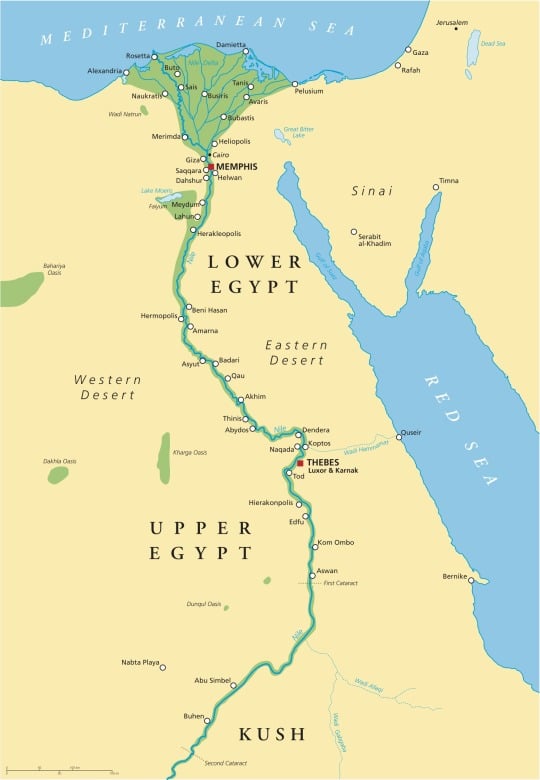Africa's Gold: The Nile
Context: International River Day
1. About
- Nile River, Arabic Baḥr Al-Nīl or Nahr Al-Nīl, is the longest river in the world, called the father of African rivers. It rises south of the Equator and flows northward through northeastern Africa to drain into the Mediterranean Sea.
- It has a length of about 4,132 miles (6,650 kilometres) and drains an area estimated at 1,293,000 square miles (3,349,000 square kilometres). Its basin includes parts of Tanzania, Burundi, Rwanda, the Democratic Republic of the Congo, Kenya, Uganda, South Sudan, Ethiopia, Sudan, and the cultivated part of Egypt. Its most distant source is the Kagera River in Burundi.
- The Nile is formed by three principal streams: the Blue Nile and the Atbara, which flow from the highlands of Ethiopia, and the White Nile, the headstreams of which flow into Lakes Victoria and Albert.
- The name Nile is derived from the Greek Neilos (Latin: Nilus), which probably originated from the Semitic root naḥal, meaning a valley or a river valley and hence, by an extension of the meaning, a river. The fact that the Nile—unlike other great rivers known to them—flowed from the south northward and was in flood at the warmest time of the year was a mystery to the ancient Egyptians and Greeks.
- The Nile, the longest river in the world, is one of the frontlines of conflict over its water as climate change sweeps Africa and the world.
- The river’s precious waters have been valued since antiquity but have been in the news since the last decade over Ethiopia building a huge dam upstream, much to Egypt and Sudan’s chagrin.

2. Can all countries compete for the Nile for the same cause?
- Nile riparian countries had a history of both conflicts and cooperation over the years.
- This was illustrated by the various agreements concluded and institutions established at one time or another by the riparian countries.
- “Examples include 1929, 1959 Nile water agreements and Cooperative Framework Agreement of the Nine Basin Initiative which is an intergovernmental partnership of 10 Nile Basin countries. However, these agreements are not as effective because they fail to include all riparian countries,”
- None of these countries are suitable for all the economic activities that one can obtain from the river. Rather, each country has their comparative advantage.
- For instance, the water of the Nile would be saved from evaporation by having dams in the upstream countries. Sudan is also said to be the best place for irrigated agriculture. If the riparian countries came into such a common understanding, they would have been able to cooperate rather than go into a never-ending conflict.
3. The Historical context
- The Nile is the longest river in the world and brings together 11 riparian countries. These are the Democratic Republic of the Congo, Burundi, Uganda, Kenya, South Sudan, Ethiopia, Eritrea, Rwanda, Tanzania, Sudan and Egypt.
- The Nile is made up of two main tributaries. There is no consensus on what is the most distant source of the White Nile. But its journey northwards starts at Jinja on the northern shore of Lake Victoria in Uganda.
- The White Nile meets the Blue Nile at Khartoum, the Sudanese capital. The Blue Nile originates from Lake Tana in Ethiopia. The unified stream from Khartoum continues north, passing through Egypt, before emptying into the Mediterranean near Alexandria.
- The history of Nile water sharing in Ethiopia is as old as the country itself.
- Historians and clergymen in Ethiopia often cite quotations from documents of antiquity, including the Bible to claim that God has given Nile water to Ethiopia
Note-‘Cush’ refers to the region where Sudan, Eritrea and Ethiopia are today.
4. The disputes
- “Historically, wars have been fought over the Nile, particularly between Egypt and Ethiopia. In the 20th century, the conflicts have not turned into wars but there have been many instances of disagreements between Ethiopia and Egypt,”.
- She added that these conflicts had their roots in colonial as well as other agreements of which Ethiopia was not a part of, particularly the 1959 Nile waters agreement.
- Ethiopia began construction on the Grand Ethiopian Renaissance Dam (GERD) in April 2011 on the Blue Nile. The project has fuelled controversies and repetitive unsuccessful and futile negotiations, especially among the three Nile riparian countries Ethiopia, Sudan and Egypt.
5. Concluding remarks
- But the river should unite and not divide.
- If Nile riparian countries were able to cooperate, they would be able to share ultimate benefits from the Nile.




